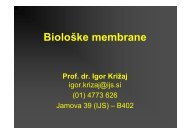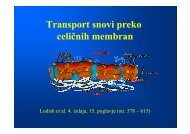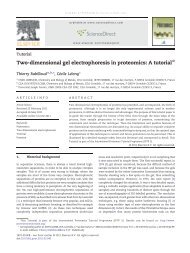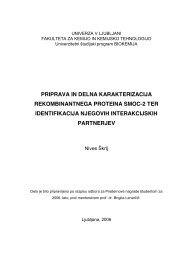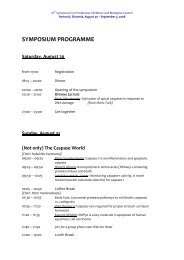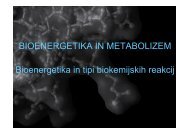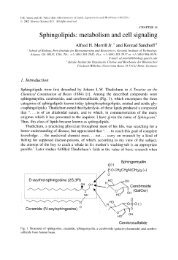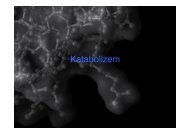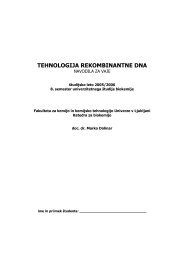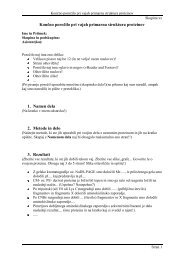Extremophiles as a source of novel enzymes for industrial application
Extremophiles as a source of novel enzymes for industrial application
Extremophiles as a source of novel enzymes for industrial application
You also want an ePaper? Increase the reach of your titles
YUMPU automatically turns print PDFs into web optimized ePapers that Google loves.
722<br />
Another drawback in sequencing e ciency is the<br />
ability <strong>of</strong> DNA polymer<strong>as</strong>es to catalyse pyrophosphorolysis,<br />
resulting in removal <strong>of</strong> dideoxynucleotides<br />
by pyrophosphate. This backward reaction h<strong>as</strong> been<br />
suppressed by adding a thermostable pyrophosphat<strong>as</strong>e<br />
from Thermopl<strong>as</strong>ma acidophilum (Vander et al. 1997).<br />
Degradation <strong>of</strong> the inorganic pyrophosphate, there<strong>for</strong>e,<br />
results in a more e cient termination reaction. Several<br />
other bacterial thermostable polymer<strong>as</strong>es have been<br />
described <strong>for</strong> use in cycle sequencing (Table 4), namely<br />
Bst DNA polymer<strong>as</strong>e from Bacillus stearothermophilus<br />
(Mead et al. 1991) or T¯ DNA polymer<strong>as</strong>e from Thermus<br />
¯avus (Rao and Saunders 1992). The most thermostable<br />
DNA polymer<strong>as</strong>es are derived from<br />
hyperthermophilic archaea and are there<strong>for</strong>e highly desirable<br />
<strong>for</strong> <strong>application</strong> in cycle reactions. Unlike the<br />
above-mentioned PolI-like polymer<strong>as</strong>es, these archaeal<br />
a-like DNA polymer<strong>as</strong>es exhibit strong 3¢±5¢-exonucle<strong>as</strong>e<br />
activity, which is detrimental <strong>for</strong> DNA sequencing.<br />
As a result <strong>of</strong> this intrinsic pro<strong>of</strong>-reading activity,<br />
the incorporation <strong>of</strong> dideoxynucleotides is inhibited almost<br />
completely. By comparing the primary sequence <strong>of</strong><br />
several a-type polymer<strong>as</strong>es, active sites responsible <strong>for</strong><br />
3¢±5¢-exonucleolytic activity were detected and altered<br />
by site-speci®c mutagenesis producing polymer<strong>as</strong>es<br />
suitable <strong>for</strong> cycle sequencing reactions (Kong et al. 1993;<br />
Perler et al. 1996; Sears et al. 1992; Southworth et al.<br />
1996).<br />
Lig<strong>as</strong>e chain reaction<br />
A variety <strong>of</strong> analytical methods are b<strong>as</strong>ed on the use <strong>of</strong><br />
thermostable lig<strong>as</strong>es. Of considerable potential is the<br />
construction <strong>of</strong> sequencing primers by high-temperature<br />
ligation <strong>of</strong> hexameric primers (Szybalski 1990), the detection<br />
<strong>of</strong> trinucleotide repeats through repeat expansion<br />
detection (Schalling et al. 1993) or DNA detection by<br />
circularization <strong>of</strong> oligonucleotides (Nilsson et al. 1994).<br />
Tremendous improvements have been made in the<br />
®eld <strong>of</strong> heritable dise<strong>as</strong>es. A powerful analytical method<br />
<strong>for</strong> detecting single b<strong>as</strong>e mutations in speci®c nucleotide<br />
sequences utilizes DNA lig<strong>as</strong>es (Landegren et al. 1988).<br />
Two oligonucleotides are hybridized to a DNA template,<br />
so that the 3¢ end <strong>of</strong> the ®rst one is adjacent to the<br />
5¢ end <strong>of</strong> the second one. In the event that the two<br />
oligonucleotides are perfectly b<strong>as</strong>e-paired, a DNA lig<strong>as</strong>e<br />
can link them covalently (Wu and Wallace 1989). A<br />
major drawback <strong>of</strong> this method is the detection <strong>of</strong> relative<br />
small amounts <strong>of</strong> ligated product and the high<br />
background due to unspeci®c ligation by the applied T4<br />
DNA lig<strong>as</strong>e. These problems have been overcome by the<br />
invention <strong>of</strong> the lig<strong>as</strong>e chain reaction (Barany 1991). In a<br />
preceding step a thermostable lig<strong>as</strong>e links two adjacent<br />
primers at a temperature above 60 °C. This product is<br />
ampli®ed exponentially in the presence <strong>of</strong> a second set <strong>of</strong><br />
complementary oligonucleotides when denaturation,<br />
annealing and ligation are repeated several times, <strong>as</strong> in<br />
the polymer<strong>as</strong>e chain reaction. The speci®city <strong>of</strong> the<br />
ligation reaction is dramatically enhanced by per<strong>for</strong>ming<br />
the reaction near the melting point <strong>of</strong> the primers. Remarkably,<br />
the ®rst thermostable DNA lig<strong>as</strong>e w<strong>as</strong> described<br />
in 1984. It w<strong>as</strong> derived from T. thermophilus<br />
HB8 (Takah<strong>as</strong>hi et al. 1984) and displayed a wide temperature<br />
range between 15 °C and85°C with an optimum<br />
at 70 °C. This enzyme w<strong>as</strong> cloned and<br />
overexpressed 7 years later independently by two different<br />
groups (Barany and Gelfand 1991; Lauer et al.<br />
1991). Over the years several additional thermostable<br />
DNA lig<strong>as</strong>es have been discovered. Bacterial <strong>enzymes</strong><br />
were derived and cloned from Thermus scotoductus<br />
(Jonsson et al. 1994) and Rhodothermus marinus<br />
(Thorbjarnardottir et al. 1995). Recent studies in the<br />
crude extract <strong>of</strong> 103 strains <strong>of</strong> the genera Thermus, Bacillus,<br />
Rhodothermus and Hydrogenobacter have revealed<br />
the presence <strong>of</strong> thermostable DNA lig<strong>as</strong>es in 23 <strong>of</strong> the<br />
Thermus strains (HjoÈ rleifsdottir et al. 1997). Up to now<br />
only one archaeal DNA lig<strong>as</strong>e from Desulfurolobus<br />
ambivalens h<strong>as</strong> been described (Kletzin 1992). Unlike<br />
bacterial <strong>enzymes</strong>, this lig<strong>as</strong>e is NAD + -independent but<br />
ATP-dependent, similar to the <strong>enzymes</strong> from bacteriophages,<br />
eukaryotes and viruses.<br />
Other <strong>enzymes</strong> <strong>of</strong> biotechnological interest<br />
In addition to polymer-degrading and DNA-modifying<br />
<strong>enzymes</strong>, other <strong>enzymes</strong> from extremophiles are expected<br />
to play a role in <strong>industrial</strong> processes involving<br />
reactions like transesteri®cation and peptide, oligosaccharide<br />
and phospholipid synthesis (Table 5).<br />
Glucose isomer<strong>as</strong>es<br />
Glucose isomer<strong>as</strong>e or xylose isomer<strong>as</strong>e (D-xylose<br />
ketol-isomer<strong>as</strong>e; EC 5.3.1.5) catalyses the reversible isomerization<br />
<strong>of</strong> D-glucose and D-xylose to D-fructose and<br />
D-xylulose respectively. The enzyme h<strong>as</strong> the largest<br />
market in the food industry because <strong>of</strong> its <strong>application</strong> in<br />
the production <strong>of</strong> high-fructose corn syrup. This equilibrium<br />
mixture <strong>of</strong> glucose and fructose is 1.3 times<br />
sweeter than sucrose. Glucose isomer<strong>as</strong>e is widely distributed<br />
in mesophilic microorganisms, and intensive<br />
research e€orts are being directed towards improving its<br />
suitability <strong>for</strong> <strong>industrial</strong> <strong>application</strong>. In order to achieve a<br />
fructose concentration <strong>of</strong> 55% the reaction must approach<br />
110 °C. Improved thermostable glucose isomer<strong>as</strong>es<br />
have been engineered from mesophilic <strong>enzymes</strong><br />
(Crabb and Mitchinson 1997). The gene encoding a xylose<br />
isomer<strong>as</strong>e (XylA) <strong>of</strong> Thermus ¯avus AT62 w<strong>as</strong><br />
cloned and the DNA sequence w<strong>as</strong> determined. XylA<br />
(185 kDa; 45 kDa/subunit) h<strong>as</strong> its optimum activity at<br />
90 °C and pH 7.0; divalent cations such <strong>as</strong> Mn 2+ ,Co 2+<br />
and Mg 2+ are required <strong>for</strong> the enzyme's activity (Park<br />
et al. 1997). Thermoanaerobacterium strain JW/SL-YS<br />
489 <strong>for</strong>ms a xylose isomer<strong>as</strong>e (200 kDa; 50 kDa/subunit)<br />
that is optimally active at pH 6.4 (60 °C) or pH 6.8




